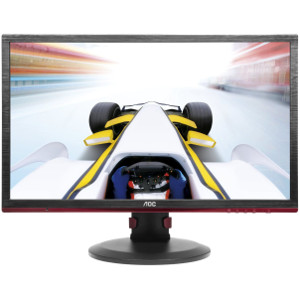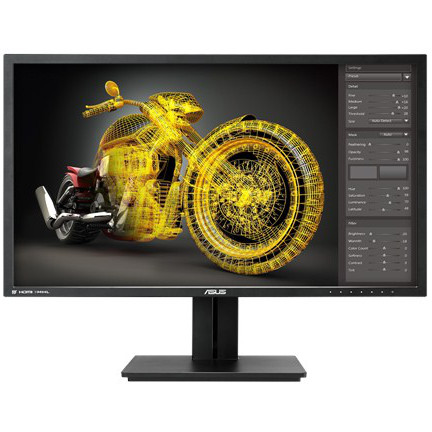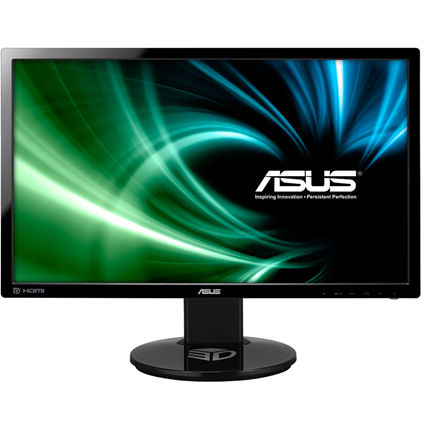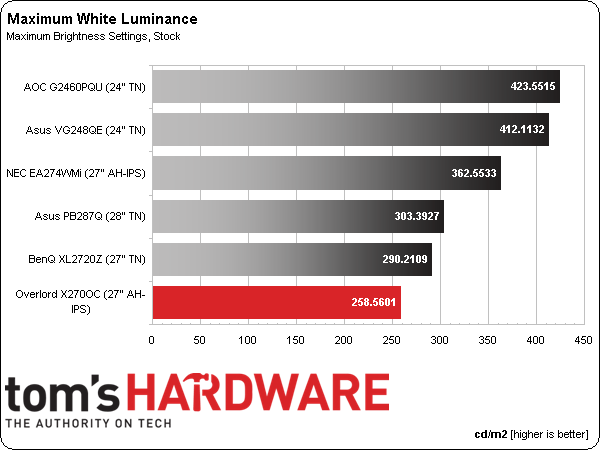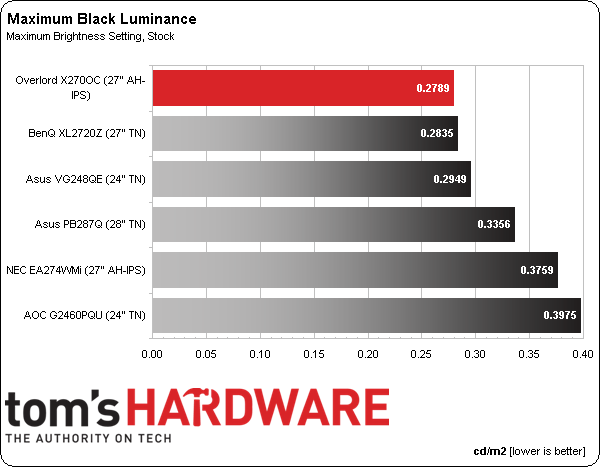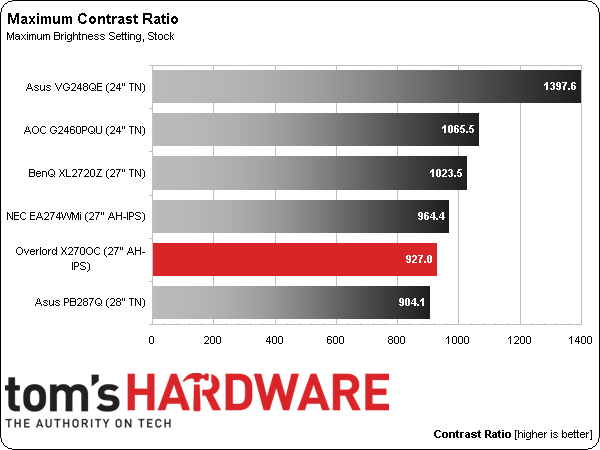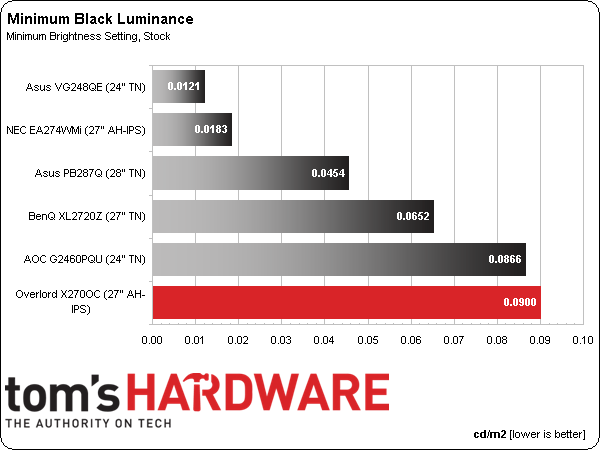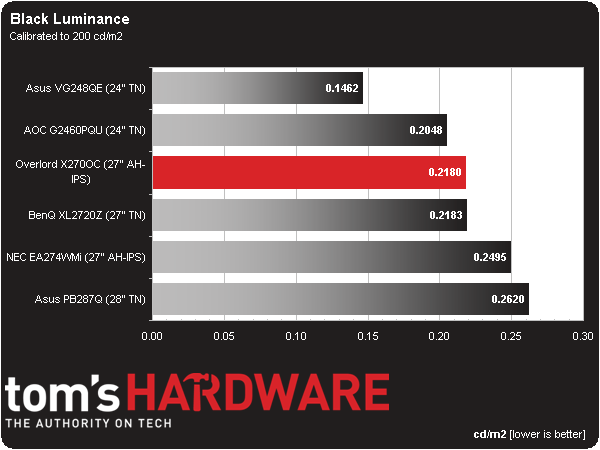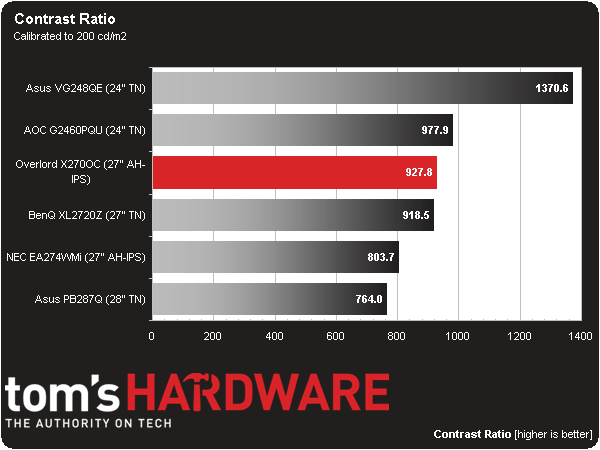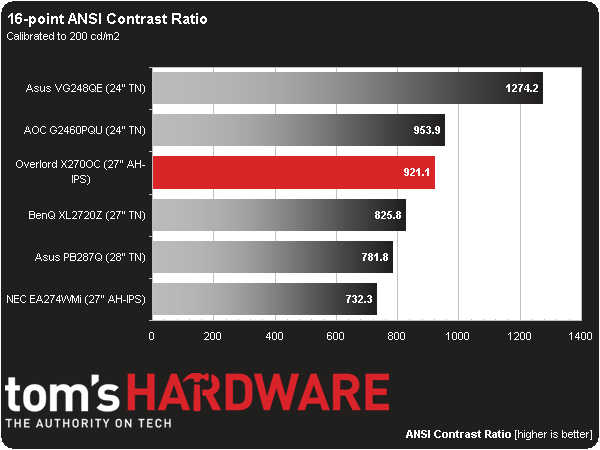Overlord Tempest X270OC, 27" 120 Hz IPS Gaming Monitor Review
After many reader requests to review Overlord’s 120 Hz 27-inch QHD monitor, we finally got a brand new X270OC in our labs. It’s the only IPS screen we know of that can exceed a 60 Hz refresh rate. We run it through our benchmark and usability test suite.
Results: Brightness and Contrast
The X270OC would not accept a signal from our AccuPel signal generator, so all measurements were taken with Overlord's monitor connected to a PC via DVI. Patterns were rendered by CalPC Client 3. We took default readings with all look-up tables turned off to be sure we were recording raw values. After creating a custom LUT with CalPC, we measured the results.
Uncalibrated
Before calibrating any panel, we measure zero and 100-percent signals at both ends of the brightness range. This shows us how contrast is affected at the extremes of a monitor's luminance capability. The X270OC does not have a contrast control, so signal clipping is not an issue. Light output can only be modulated using brightness, which affects the backlight level.
Today’s comparison group consists of the high-refresh gaming monitors we’ve reviewed, plus Asus' value-oriented 4K display, the PB287Q. I'm also adding a typical 27-inch IPS screen, NEC’s EA274WMi.
Overlord rates the X270OC at 380 cd/m2. The most light we measured was 258.5601 cd/m2, though. It's probable that Overlord is citing the panel part's specification. Typical gameplay doesn't require a super-bright display, so this shouldn't be a tremendous issue.
A low maximum black level beats the TN-based panels in our comparison. When I checked our database, I found that Overlord's X270OC bests almost all of the other IPS screens as well.
NEC's screen trumps the Tempest only because of its higher white level. The same is true of this group's other models. Among IPS displays, however, Overlord is at or near the top for maximum contrast.
We believe 50 cd/m2 is a practical minimum standard for screen brightness. Any lower and you risk eyestrain and fatigue. The X270OC bottoms out at 83.0312 cd/m2, which is a great light level for playing games in total darkness. As you’ll see below, black levels and contrast also hold up extremely well.
Get Tom's Hardware's best news and in-depth reviews, straight to your inbox.
A last-place result in this test isn't a big deal when you’re talking about such low black levels. If all of the monitors were lined up in a row, it'd be a challenge to pick the darkest one.
The Tempest’s contrast remains super-consistent at all brightness levels. We’re seeing a positive trend towards better contrast performance from both TN and IPS screens. That Overlord can offer results this good with a $450 display is impressive.
After Calibration
Since we consider 200 cd/m2 to be an ideal point for peak output, we calibrate all of our test monitors to that value. In a room with some ambient light (like an office), this brightness level provides a sharp, punchy image with maximum detail and minimum eye fatigue. On many monitors, it’s also the sweet spot for gamma and grayscale tracking, which we'll look at on the next page. Many professionals prefer a 120 cd/m2 calibration in darker rooms. We find that makes little to no difference on the calibrated black level and contrast measurements.
We set the maximum output level using the X270OC’s only available adjustment, brightness. Our results reflect the color and gamma adjustments made by the CalPC-generated LUT.
A calibrated black level result of .218 cd/m2 is excellent. Typically, monitors take a small hit after we adjust them. But not the Tempest. Perhaps this is attributable to the finer control possible with a software LUT. Most displays employ OSD controls that aren't as precise.
An improvement like this makes calibration worth the time and expense, though.
The X270OC posts incredibly consistent contrast results. Whether you calibrate or not, and regardless of backlight setting, the contrast ratio is always around 925 to 1.
ANSI Contrast Ratio
Another important measure of contrast is ANSI. To perform this test, a checkerboard pattern of sixteen zero and 100-percent squares is measured. We get a somewhat more real-world metric than on/off measurements because we're testing the display’s ability to simultaneously maintain both low black and full white levels, plus factoring in screen uniformity. The average of the eight full-white measurements is divided by the average of the eight full-black measurements to arrive at the ANSI result.
The Tempest loses no ground in the ANSI contrast test. Since screen uniformity is a factor, some samples will measure better or worse than ours. Even still, it's impressive to come across such strong build quality from a low-priced IPS display.
Current page: Results: Brightness and Contrast
Prev Page Measurement and Calibration Methodology: How We Test Next Page Results: Grayscale Tracking and Gamma Response
Christian Eberle is a Contributing Editor for Tom's Hardware US. He's a veteran reviewer of A/V equipment, specializing in monitors. Christian began his obsession with tech when he built his first PC in 1991, a 286 running DOS 3.0 at a blazing 12MHz. In 2006, he undertook training from the Imaging Science Foundation in video calibration and testing and thus started a passion for precise imaging that persists to this day. He is also a professional musician with a degree from the New England Conservatory as a classical bassoonist which he used to good effect as a performer with the West Point Army Band from 1987 to 2013. He enjoys watching movies and listening to high-end audio in his custom-built home theater and can be seen riding trails near his home on a race-ready ICE VTX recumbent trike. Christian enjoys the endless summer in Florida where he lives with his wife and Chihuahua and plays with orchestras around the state.
-
oudmaster the price is interesting with these specs !Reply
any idea if there will be a similar monitor spec but 4k resolution ?
thanks, -
oudmaster the price is interesting with these specs !Reply
any idea if there will be a similar monitor spec but 4k resolution ?
thanks, -
wtfxxxgp Crickey me...this is a monitor of note it seems! At that price point, I find it incredible. Well done to Overlord! The only issue I have now is... will the price increase as a result of all the buzz this will generate? This is probably going to be my next monitor, depending on exchange rates...Reply -
Swiperd3 Driving QHD to 120 FPS at the max graphics detail is sure as hell will require A LOT of horsepower. Will TOP-SLI/CF-x2 be enough for modern FPS games?Reply -
Traciatim Wow, you get this with one of the variable sync techs and you have yourself one fantastic monitor.Reply -
Reaver192 Yeah, I've been waiting fir this for too long. I wanted one of these months ago but they have been out of stock. Such a sweet dealReply
